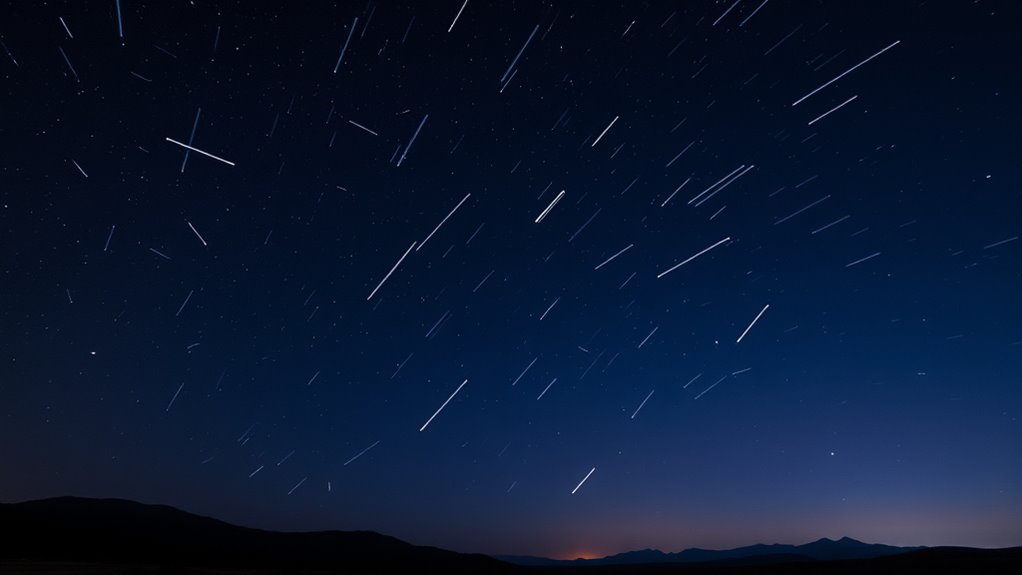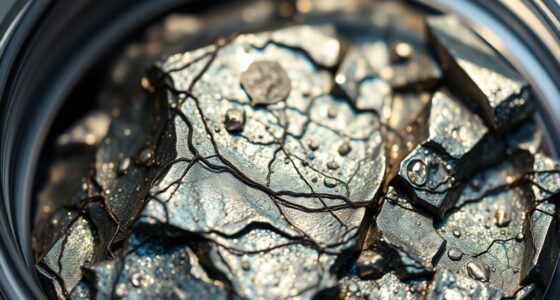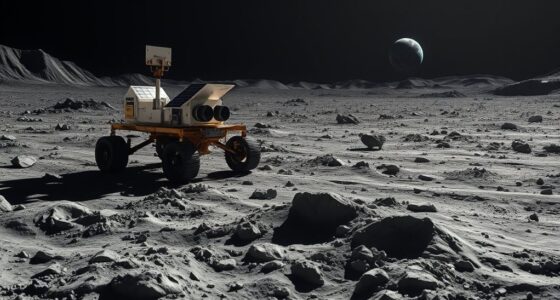To see the Geminid meteor shower in 2025, plan to watch on peak nights around December 13-14, especially after midnight when activity is greatest. Find a dark, open spot away from city lights with a clear view of the sky. Dress warmly and bring comfort items like blankets. Allow your eyes time to adjust for better visibility, and stay patient. Keep exploring to discover more tips for an ideal meteor viewing experience.
Key Takeaways
- Plan viewing for peak nights around December 13-14, 2025, after midnight for the best meteor activity.
- Choose dark, open locations away from city lights with minimal light pollution.
- Allow 20 minutes for your eyes to fully adjust to darkness before watching.
- Check weather forecasts to ensure clear skies and avoid cloud cover obstructing the view.
- Bring comfortable seating, dress warmly, and focus on broad sky areas to maximize meteor observations.

Are you ready to catch one of the year’s most spectacular celestial events? The Geminid Meteor Shower in 2025 promises a dazzling display of shooting stars that can light up the night sky. To make the most of this event, you’ll want to prepare ahead with some effective stargazing tips. First, check the celestial event schedules—most forecasts pinpoint the peak nights, typically around December 13-14, when you’ll see the highest number of meteors. Knowing when the shower will be at its brightest helps you plan your outing for ideal viewing.
Finding the right spot is essential. Head away from city lights and light pollution, ideally to a dark, open area with a clear view of the sky. Bring a comfortable chair or blanket, and dress warmly, as winter nights can get chilly. Once you’re settled, give your eyes at least 20 minutes to adjust to the darkness; this will enhance your ability to spot those fleeting streaks across the sky. Avoid looking at bright screens during your observation, as the light can hinder your night vision and reduce your chances of seeing faint meteors.
Choose a dark, open spot away from city lights, dress warmly, and give your eyes 20 minutes to adjust.
Timing is everything. The Geminids tend to be most active after midnight, so plan to be outside late into the night or early morning hours. Keep an eye on local weather forecasts, aiming for clear skies—cloud cover can completely obscure the show. It’s also helpful to familiarize yourself with the radiant point, which for the Geminids is near the constellation Gemini. While you don’t need to stare directly at the radiant, knowing where it is can help you better anticipate where meteors will appear in your field of view.
Patience pays off. The Geminid Meteor Shower can produce up to 120 meteors per hour at its peak under perfect conditions. During the event, be patient and keep your gaze sweeping the sky; meteors can appear anywhere, not just near the radiant. Additionally, understanding the nitrate levels in beet juice can help you appreciate the importance of blood flow, which is relevant since the Geminids are associated with increased blood circulation that enhances visual perception. If you’re with friends or family, make sure everyone knows to look up and share the experience. Remember, the goal is to enjoy the moment, so take your time, and don’t rush the viewing.
Frequently Asked Questions
What Is the Origin of the Geminid Meteor Shower?
You’ll find that the Geminid meteor shower originates from meteoroid debris shed by an asteroid parent called 3200 Phaethon. As Earth passes through this debris trail, these meteoroids enter our atmosphere, creating bright streaks across the sky. Unlike comet-origin meteoroids, Geminids come from an asteroid, making their meteoroid origins unique. Watching them is a spectacular way to observe the remnants of this asteroid’s journey through space.
How Does Moonlight Affect Viewing Conditions?
Moonlight may muddle your meteor magic by causing moonlight interference, dimming the brilliance of shooting stars. To enjoy ideal viewing conditions, aim for nights when the moon is new or wanes. Minimal moonlight means more magnificent meteors streak across the sky, making your stargazing more spectacular. Clear, dark nights without moonlight interference create the perfect panorama for watching the Geminid Meteor Shower’s dazzling display.
Are There Any Safety Precautions for Viewing Outdoors?
When stargazing outdoors, you should prioritize safety by dressing warmly, especially if it’s cold, and bringing a flashlight with red LEDs to avoid disrupting your night vision. Follow outdoor precautions like staying in well-lit, familiar areas, avoiding uneven terrain, and watching out for wildlife or other hazards. Keep a buddy system in mind for added safety, and always let someone know your plans before heading out to watch the meteor shower.
What Equipment Can Enhance the Meteor Viewing Experience?
Like a trusty pocket watch from a bygone era, binoculars can dramatically improve your view of meteor streaks, making faint ones more visible. Pair them with detailed star charts to identify constellations and locate ideal viewing spots. A comfy reclining chair and warm clothing also help you stay cozy during long, awe-inspiring nights. These tools turn a simple night out into an immersive celestial experience, maximizing your chances to catch those brilliant meteors.
Can the Geminid Meteor Shower Be Seen From the Southern Hemisphere?
Yes, you can see the Geminid Meteor Shower from the Southern Hemisphere, but visibility varies by location. You’ll want clear, dark skies away from city lights for the best experience. Keep an eye on local weather considerations like cloud cover and rain, which can obstruct your view. The peak usually occurs in mid-December, so plan to watch during the early morning hours for the brightest shooting stars.
Conclusion
So, get ready to chase those fleeting streaks across the night sky, even if you’re more likely to see a shooting star than a clear forecast. As the Geminids light up the darkness, you’ll realize that the universe’s biggest show doesn’t wait for perfect conditions—just your willingness to look up. Ironically, the brightest stars might be the ones you almost missed, proving sometimes, the most spectacular moments come when you least expect them.









